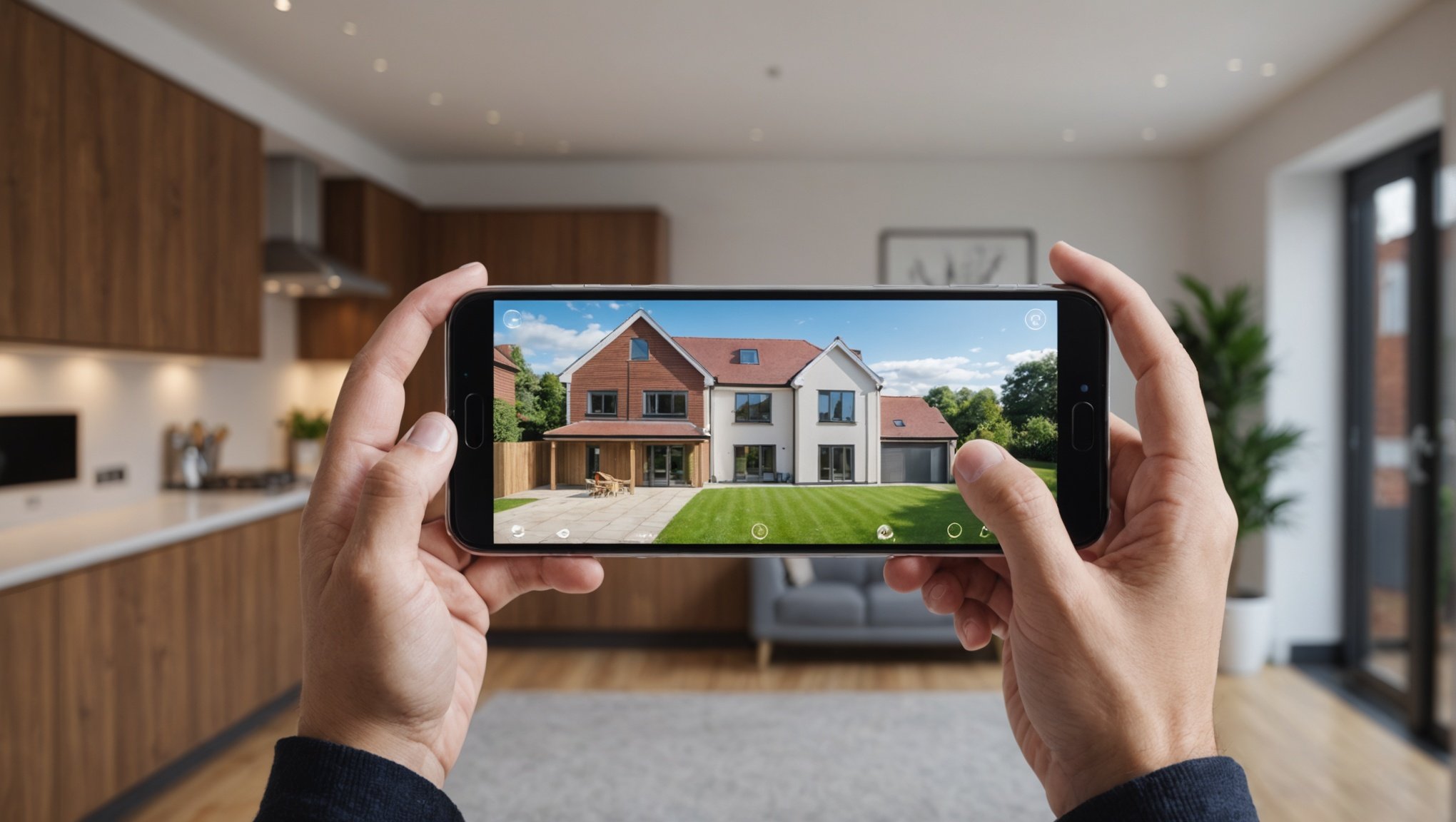Transforming Property Showings: The Role of Augmented Reality in Virtual Tours for UK Real Estate Agencies
The real estate industry in the UK is undergoing a significant transformation, driven by the integration of advanced technologies such as augmented reality (AR) and virtual reality (VR). These innovations are revolutionizing the way properties are showcased, making the process more efficient, engaging, and convenient for both estate agents and potential buyers.
The Evolution of Virtual Property Tours
In the past, property viewings were limited to physical visits, which could be time-consuming and often inconvenient for both parties. However, with the advent of virtual reality and augmented reality, the landscape of property tours has changed dramatically.
Also to see : Top Strategies for UK Consultants to Elevate Client Relationship Management Effectively
From Static Images to Immersive Experiences
Traditional property listings relied heavily on static images and written descriptions, which often failed to capture the full essence of a property. In contrast, virtual and augmented reality technologies offer immersive experiences that allow potential buyers to explore properties remotely.
“Virtual reality is revolutionizing the real estate industry by offering immersive experiences that transform how properties are showcased,” notes an expert from Knight Frank, a leading UK real estate agency. “This technology allows potential buyers to explore properties remotely, providing a sense of space and design without physical presence”.
This might interest you : Unlocking Growth: Harnessing Cloud Computing for Scalability and Efficiency in UK SMEs
How Augmented Reality Enhances Virtual Tours
Augmented reality is particularly adept at enhancing the virtual tour experience by overlaying digital information onto the real world. Here are some ways AR is making a significant impact:
Interactive and Immersive Experiences
AR enables potential buyers to interact with properties in a more engaging way. For example, using AR, buyers can see how furniture would look in a room or how different colors would appear on the walls. This interactive feature helps buyers visualize themselves living in the space more effectively.
“Augmented reality adds a new layer to the narrative, providing an interactive experience that goes beyond conventional photos,” explains Robin Waite, a specialist in real estate marketing. “This technology allows buyers to virtually walk through properties from the comfort of their homes, making the decision-making process much easier”.
Real-Time Customization
One of the standout features of AR in virtual tours is the ability to customize the property in real-time. Buyers can change the layout, colors, and even the furniture to see how the space would look according to their preferences. This real-time customization is a game-changer in the real estate industry.
Key Technologies Driving AR in Property Showcases
Several technologies are driving the adoption of AR in property showcases:
High-Definition 3D Modeling
High-definition 3D modeling creates realistic representations of properties, allowing buyers to explore every nook and cranny in detail. This technology is crucial for creating immersive virtual tours.
Interactive Features
Interactive features such as virtual try-on for furniture and decor, and the ability to measure rooms and spaces, make the virtual tour experience highly engaging and practical.
AR Headsets and Mobile Apps
AR headsets and mobile apps are making it easier for buyers to access and interact with virtual tours. These tools provide a fully immersive environment, enhancing the overall experience.
Benefits of Using AR in Virtual Property Tours
The benefits of using AR in virtual property tours are numerous and significant:
Enhanced Viewing Experience
- Immersive Exploration: AR allows potential buyers to explore properties in detail, fostering a deeper emotional connection.
- Interactive Customization: Buyers can customize the property in real-time, helping them visualize themselves living in the space.
- Convenience: Remote viewing reduces the need for physical visits, saving time and effort for both buyers and agents.
Improved Customer Engagement
- Increased Interaction: Interactive features keep potential buyers interested and invested in the properties they are viewing.
- Quicker Decision Making: The immersive and interactive nature of AR tours can lead to quicker sales and increased client satisfaction.
Cost Efficiency
- Reduced Costs: Virtual tours reduce the need for multiple physical viewings, saving costs associated with travel and property maintenance.
- Broader Reach: AR tours can be shared on social media and online platforms, reaching a broader audience and attracting international buyers.
Successful Case Studies of AR in UK Real Estate
Several UK real estate agents have successfully integrated AR into their marketing strategies, leading to compelling success stories.
Knight Frank and Savills
Leading real estate agents like Knight Frank and Savills have been at the forefront of using AR to offer virtual tours that attract a global clientele. For instance, Knight Frank showcased a luxury penthouse in London through a fully immersive VR tour, allowing potential buyers to explore the space in detail from anywhere in the world.
Measurable Outcomes and Feedback from Clients
The impact of AR on real estate transactions is evident in measurable outcomes:
Quicker Sales and Higher Engagement
- Properties showcased through AR have seen quicker sales and higher engagement rates.
- Clients have provided positive feedback, appreciating the convenience and immersive experience that AR offers.
Client Feedback
“Using AR to view properties has been a game-changer for us. It allowed us to explore homes in detail without the need for multiple physical visits,” said a satisfied client. “The interactive features helped us visualize how the space would look with our furniture and decor, making the decision-making process much easier.”
Practical Insights and Actionable Advice for Estate Agents
For estate agents looking to integrate AR into their marketing strategies, here are some practical insights and actionable advice:
Invest in High-Quality 3D Modeling
- High-definition 3D modeling is essential for creating realistic and immersive virtual tours.
Utilize Interactive Features
- Incorporate interactive features such as virtual try-on and room measurement tools to enhance the viewing experience.
Leverage Social Media
- Share AR tours on social media platforms to reach a broader audience and attract potential buyers.
Train Staff
- Ensure that your staff is well-trained in using AR technology to provide the best possible experience for clients.
Table: Comparing Traditional Property Viewings with AR-Enhanced Virtual Tours
| Feature | Traditional Property Viewings | AR-Enhanced Virtual Tours |
|---|---|---|
| Convenience | Requires physical visits, time-consuming | Remote viewing, convenient and time-saving |
| Interactivity | Limited interaction, static experience | Highly interactive, customizable |
| Cost | High costs associated with travel and maintenance | Reduced costs, broader reach |
| Engagement | Lower engagement rates, less immersive | Higher engagement rates, more immersive |
| Decision Making | Slower decision-making process | Quicker decision-making process |
| Reach | Limited to local buyers | Global reach through online platforms |
The integration of augmented reality into virtual property tours is transforming the UK real estate market. By offering immersive, interactive, and customizable experiences, AR is enhancing the viewing process, improving customer engagement, and driving cost efficiency. As technology continues to advance, it is clear that AR will play a pivotal role in the future of real estate marketing.
“Augmented reality is not just a tool; it’s a game-changer in the real estate industry,” concludes Robin Waite. “It’s about creating an emotional connection with potential buyers and providing them with an experience that goes beyond conventional property listings”.
For estate agents and professionals in the industry, embracing AR technology is not just an option but a necessity to stay competitive and provide the best possible service to their clients. As we move forward, it’s exciting to see how these technologies will continue to evolve and shape the future of the real estate market.











